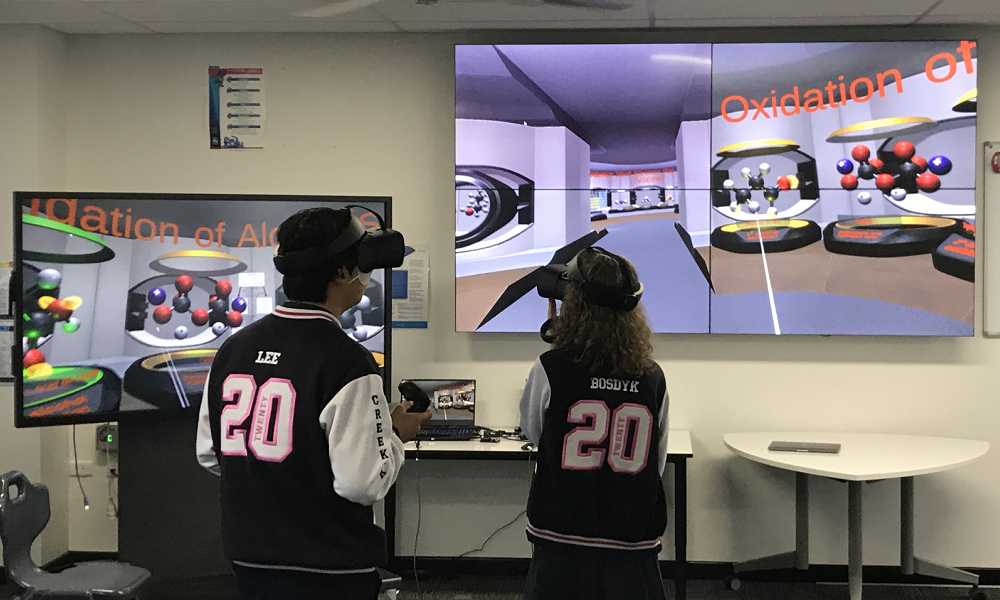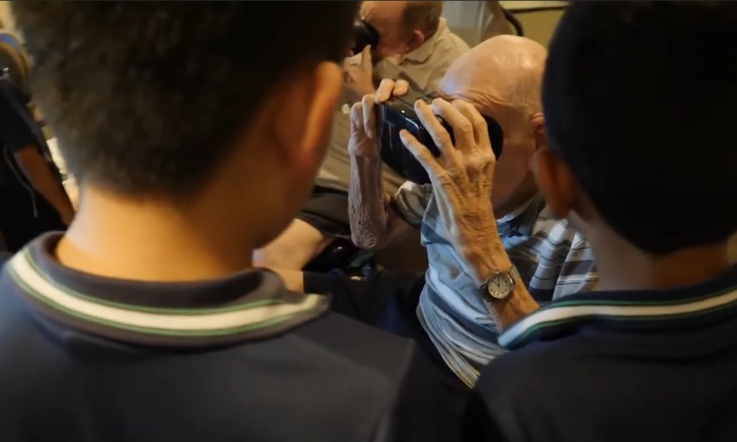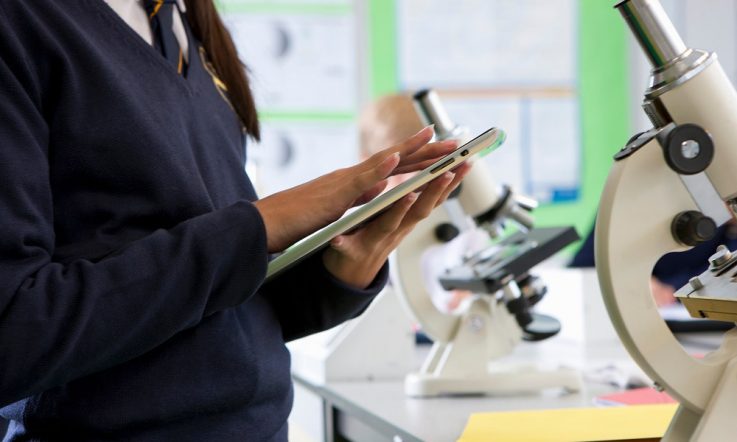Thanks for downloading this episode of School Improvement from Teacher magazine. I'm Dominique Russell. I'm joined today by Chemistry teacher Chris Buswell from Mountain Creek State High School on the Sunshine Coast in Queensland.
Chris is passionate about integrating technology into science and leveraging opportunities for students in their local community. He's worked hard for years towards both of these goals and student outcomes and their post-school destinations are really reflecting this.
As you'll hear in this episode, Chris has facilitated the use of virtual reality with senior secondary students to help them understand complex chemistry concepts through a partnership with their local university, the University of the Sunshine Coast. He's also part of a network of schools who have partnered with schools in Papua New Guinea for a program which aims to empower future leaders in STEM. And, of course, he's doing important work as well with younger students to build those important 21st Century skills. Let's jump in and hear Chris explain his school context and his role as Chemistry specialist and Higher Order Thinking Coach.
Dominique Russell: Chris, thanks for joining me for this episode of School Improvement. I just would love to hear a bit more about Mountain Creek State High School to start off, and your role there too.
Chris Buswell: Yeah, thanks for having me. So, Mountain Creek State High School is on the Sunshine Coast, so about an hour north of Brisbane. So we're a regional, state independent school. We've got about 2200 students, growing to about 2800 in the next couple years.
So we've just had a new STEM building built which is allowing us to increase our population. So yeah, we're a mixed school. We run the QCAA program, which is the Queensland State Curriculum, as well as the International Baccalaureate (IB), so we were the first school in Queensland to start the IB and yeah, we've got a proud history and a very diverse population, actually. We cross a lot of demographics. We have a large proportion of our population that take a vocational pathway, right to the other end of the academic kids that take a university pathway. So, yeah, interesting mix of kids.
I've been at Mountain Creek for eight years now. And yeah, so started off as a Science teacher. And that's merged into what we call STEM now. I'm a Chemistry specialist. But my role, I ran the International Baccalaureate program for a few years and now I lead the critical thinking strategy as the Higher Order Thinking Coach at the school. Yeah so my role is about, you know, coaching staff and about … I guess I'm involved in a lot of science-based programs in the school and I reach out. I've been involved in international partnerships, which I hope to talk about a little bit today. So yeah, fantastic school and I love my job there and the community we have here on the Coast.
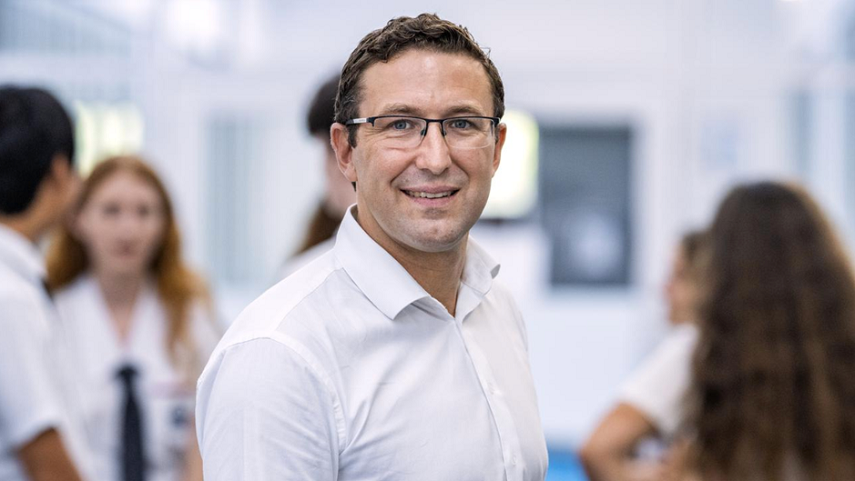
Chris Buswell. Image supplied.
DR: Fantastic. And so you mentioned there that you're a Chemistry specialist, so you've obviously done a lot of work in improving student engagement and achievement in Chemistry. Can you tell me a bit about this work and how you're going about it?
CB: Yeah. So Chemistry for me, I guess, I really understand what kids go through when it comes to learning Chemistry. You know, a lot of kids really struggle with it. And that's something I went through and I had to work really hard and then it all clicked and I just had an absolute love for it. It just sort of evolved over time, I guess.
And so my work in Chemistry, I teach across both the Queensland and the IB curriculum. And, you know, for me, my work initially when I first started teaching, was all about the practical side. Getting involved and learning reactions, getting kids engaged that way. And that's evolved as I've gone through my career. And I'm really interested in how technology can be integrated in changing Chemistry.
I guess what I found when I first started teaching about 14 years ago was that, yeah, we were teaching the same way that I was learning when I was back in school. It hadn't really changed in that time. So we've been able to take … investigations and allow kids to really be creative and to think outside the box and investigate things that, you know, we can do now with the technology that we have. So, a great example; we've got kids investigating browning in banana skins by taking images of them and analysing the pixels. Or crystal growth over – so a student investigating the growth of honey crystals. We've got students investigating things like colour change in reactions.
A fantastic investigation a student did a few years ago, they wanted to investigate the superhydrophobicity of nasturtium leaf. So, water bouncing off surfaces. So they were able to replicate that surface using a polymer. We took them to the university and used an electron microscope to image it and they were actually able to, not only replicate the surface and create a superhydrophobic material, but also then take that further and get such a define mould of that image that they were able to replicate the stomata that was found in that leaf.
So, you know, for me, that was really empowering. That's what I love about Chemistry and about my job, is that you can take kids … they just have an idea, they're curious about something, and they create a whole new method for investigating it. You know, no longer, sort of, going to Google and going ‘what can I investigate?' it's about them looking at their environment and going ‘I'd love to do that, how can we do it?'
DR: So can you tell me a bit more about your partnership with the University of the Sunshine Coast. How did it come about and what opportunities is it giving to your students?
CB: Yeah, so I guess it's all about leveraging the incredible resources you have in your region. And what I've found, when we were looking at our higher achieving students, a lot of them had this career goal to leave the Coast and go to those big universities in the cities. And for me that was an issue because it's not protecting the intellectual capital of our region, and it's not growing the opportunities for kids. And I guess it was about building culture within our region.
So about five years ago I founded the Keeping It Local program. And so, started a STEM partnership with the University of the Sunshine Coast. And that was about providing opportunities for students to see what incredible resources USC has and getting them to engage with it. And, you know, building that culture for our higher achieving students, seeing it as a pathway. So, yeah, two-day program, but the centrepiece of that was I worked and pitched an idea to the university to build a virtual reality resource for the Cave2.
Now, quick overview, the Cave2 is a visualisation studio. There's about five of them in the world, and USC has one of these. And it's one of the only universities that actually uses it for education and allows students to come in, and they build resources that allow students to visualise, you know, all sorts of things from midwifery and nursing, to biology and then all the way, now, to Chemistry. So, I pitched an idea, I drew up a story board, drew some basic animations and I said ‘I'd love to do something for my Chemistry students to come and use this resource', which is a 320 degree room, interconnected TV screens, and they walk into this space and the images are projected out into the room. They wear 3D glasses.
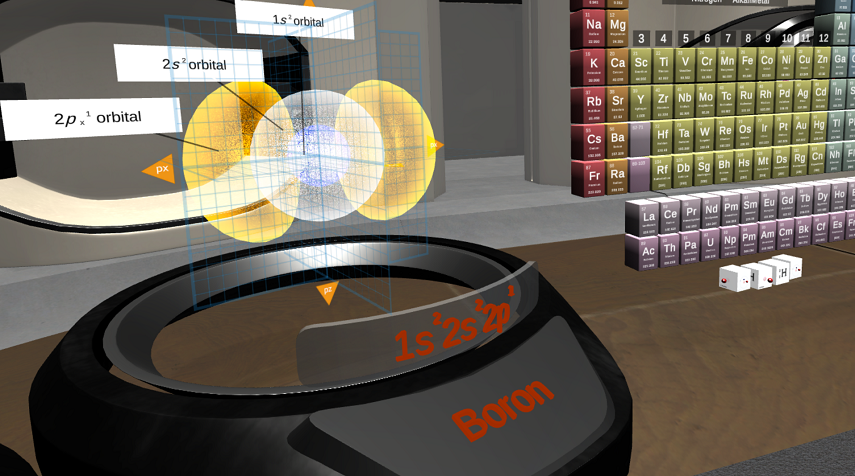
A Cave2 visualisation. Image supplied.
And yeah, so they thought the idea was great, and allocated a developer that I worked with and each year we just sort of slowly build this resource. Students came in and engaged with it. Yeah, we saw a really big uptake in, you know, students being able to take things that were very hard to represent on a 2D whiteboard, like geometrical chemistry, stereochemistry that relies heavily on that three-dimension orientation of molecules. And yeah, they were able to understand the process.
And I like to talk about this idea of aphantasia. So anyone out there that's listening, if you picture an apple right now, everyone's going to picture a different apple, that's the reality. Some people might [picture] a red apple with a leaf, or maybe they're thinking of an iPhone, who knows. But when we're trying to explain chemistry in the classroom, we're often saying to students, ‘I want you to picture this', an apple, a chemistry version of an apple, and we're getting all different versions and that translates to poor understanding and cognition in exams and assessment.
So, you know, what I wanted to do was basically create a resource that allowed everyone to see the same apple. So we're creating an image that's constant. And aphantastia is about this idea that sometimes people actually find it difficult to visualise things. So there would be a small percentage of the population out there, that when I said ‘picture an apple', they really struggle to do it. And I've seen this, at least one student every year that goes through the resource, that all of a sudden has that ‘aha' moment, that, you know, that click. And they're like ‘I finally get it, it finally makes sense to me'.
So the journey's been a long one, but we've had another growth journey in the last year. So we had something that was incredible for our region, in terms of chemistry and virtual reality, but it wasn't accessible to students in classrooms across the state or Australia and internationally. And certainly not accessible in students' own time.
So we had a goal of making it more accessible to people so we have now, over the last four months, taken what was in the cave at USC and we've developed an Oculus Rift version of it. So, been working with USC, an incredible developer, David Dickson. So we collaborate online, he's the developer that does the work through Unity and we basically work side-by-side to give feedback and discuss all the intricacies of it. And yeah, we've now got a VR resource that is 100 per cent portable. And we've done our first prototypes in the last few weeks. So we're sort of, basically at the end of that first stage. So yeah, we've started rolling it out with students. I've been showing it off to a few people around the region with some incredible feedback.
So that's the learning journey side, but also we've got a research component because we want to know what, you know, what effect this type of resource has on learning. And I think that's really in its infancy across the world. People see VR as an engagement tool. I like to think of it as it's a bit of a barbecue sizzle, students go ‘wow', and then they get excited and they come out, but we don't really know whether it's having an effect on learning.
And you know, we want to solidify our understanding but build the pedagogy that goes with VR. I've built a resource that involves the teacher, so it's, the resource isn't something that students just sit in and independently track that journey, the teacher is 100 per cent integrated and involved in creating an inquiry-based journey for the students that allows them to communicate back and forth with the teacher, but also students communicate with each other which creates, kind of that holistic sense of learning and that's what we're researching at the moment. We're kind of taking that next step. And once the pedagogy that fits this model, and you know, what's the effect on cognition and retention, and then, you know, the overall learning process and how it's integrated into a regular classroom.
DR: Fantastic, it sounds like such a valuable resource. So can we go back to Mountain Creek State High School for a second and look at the work you're doing with junior students?
CB: Yeah, certainly, so at Mountain Creek we have a junior STEM academy. So that's for our Year 7-9 students. And so we've gone aboutdefiningwhat STEM is in our own context which I think is really critical. People interpret STEM, you know, Science, Technology, Engineering, Maths, in lots of different ways. That's evolved for us over the last few years of using a design-thinking framework. But in particular, what we are about is getting students to understand technology. So it's an Arduino-based course, but we use a variety of different immersive technologies, but it's about them taking that Arduino as a prototyping tool, and building a lean-starter business around it that is sustainable. So we use the UN SDGs, the Sustainable Development Goals, to frame the solutions that the students produce.
Yeah, so that's been incredible because we've got, once again, resources that are available locally, like the Innovation Centre, and so we partner with them. And, you know, we've had students that have built businesses and they go and actually pitch it in front of 60 industry experts at the Innovation Centre. Which is, for a Year 8 student, very empowering, as you can imagine.
It always blows me away. I think we've got to realise that students, these days, have the power of what big companies had 10, 20 years ago, with the internet and the connections and the collaboration that they have. So it's about a program that allows students to leverage off that access that they have now, but really build those 21st Century Skills that they're going to need to be competitive in our current world.
That's what we're seeing. It's not about academic success any more than it's really getting students through life and building, you know, successful careers. It's their ability to really be able to really work in teams and communicate their ideas and be creative in what they do, think outside the box. They're the skills that are valued in today's society.
We know how easy it is to access knowledge, and so that program is about instilling those values really early. And then they can take that through to senior and specialise in different fields of ICT, or whatever pathway they'd like to go down.
DR: And so speaking of that, I'm interested then in the post-school destinations of your students. With your drive to be able to keep students local as much as possible, and keep their ambitions, recognise what facilities they have locally. Has that translating with students' post-school destinations at all yet, or is it still too early to tell?
CB: Yeah, no we've been tracking that data every year. So around 65 per cent of our population went to USC that chose a tertiary pathway like that last year. Which is, you know, great. But even better, in 2018 we had our IB dux that is now at USC, studying a dual degree in Arts/Law. And we also had our top Chemistry student that is now studying Chemistry teaching at USC. So you know, they're the stories that, I guess, you know, seeing that translate from the schooling journey into a career is incredible to see. The reputation and the way students see it as a pathway has certainly grown over that time.
DR: Fantastic, that's great to hear. And we mentioned at the very beginning of our conversation that you've done some work internationally. Can you tell me about this and what that's involved?
CB: Yeah, certainly. So Mountain Creek is one of 12 schools from Australia that has partnered up with 12 schools from Papua New Guinea. So, an incredible partnership that's run by the Australian Education Foundation and Australia Awards. And so it's all about empowering future leaders in STEM. So building people-to-people links. Learning a little bit about our closest neighbour. Which, to be honest, I didn't know a lot about Papua New Guinea when I first started this program, and it's really opened my eyes to how much we have in common, especially when we start looking at our First Nations People and those Indigenous connections between Papua New Guinea.
So the program is really about utilising that culture, that embedded culture that we have deep in our society and bringing it to life in STEM. So two-year partnership – so last year we were able to travel over to Papua New Guinea and we visited Port Moresby and Keravat and we worked side by side with our partner schools to use, you know, design-thinking frameworks and build lasting STEM partnerships. So the services of the people like Chris Harte, from Unstuck Learning, incredible man. Anna Antonijevic from Deeper Future, so they're involved with framing the learning that we do and then we've had to transition into the COVID phase, the online phase.
And so now we're just building the collaboration around inquiry questions at the moment. So we're talking about how do you respond positively at a time of COVID? And it's really open-ended tasks that allow students to work together and to build a project to represent what they are doing. The current project we're doing is called ‘Wash' and it's about making sure we understand how do we ensure we protect water, one of the UN Sustainability Goals, and ensure hygiene is maintained at a time of COVID. Something that the PNG population are really suffering from at the moment, making sure that they're protected from, you know, the potential ravages of COVID. So we're working together to build that partnership, so that for me is probably one of the highlights of my career.
Getting to know teachers from Papua New Guinea, their context, empathising with them. Philip Tundu, one of the physics teachers from Papua New Guinea that I've got to know really well, he teaches 70 students in his physics classroom. So that for me just blows me away. The resources are not the same, but they get their absolute results. Their students are so resilient. They work so hard for their opportunities. So you know, three per cent of the population at Papua New Guinea actually makes it on to do Year 11 and 12. So it's allowed me to contrast the society that we have in Australia with Papua New Guinea and I've learnt a lot from that. It's something that as a society and our student body that we see from today can learn from as well.
DR: Absolutely. And so, just finally then, for educators who are listening to this podcast episode who might be thinking that they're wanting to be integrate some more technology into their STEM programs at their own school or perhaps begin a university partnership like the one you've developed. Do you have any first steps that are great to take? Any advice for them?
CB: Yeah, team is absolutely critical. Everything I've talked about today has been about building a really strong team that has a clear direction and a set of values. It's all based on trust, integrity and respect. So that for me is really important. And we've always developed a BHAG, which is a Big, Hairy, Audacious Goal. So all on the way that's refined as we achieve one goal, we build another. So getting that strong foundation is critical.
Leverage off your context. Get to know what makes your context special, and make sure that you're building programs that integrate that context into what your students are doing. And the other thing is, you know, as I mentioned before. We are such a connected, global community, and you need to think globally when you're doing these projects. Get online and build those bigger communities and leverage off each other's knowledge and experience. You know, that's really critical I think.
If you're wanting to use technology, I will say one program, it's called Image J. It's allowed our students to really expand what they can do in terms of investigations. It's a freely available software. Every student has a mobile phone these days and they can take videos and images and from those videos and images they can extract data. And so it's one of the cheapest, quickest, easiest ways for a student to build an investigation and then collect data and develop conclusions from something that's quite unique. Yeah so that for me has been a big journey that I started on and there's lots of resources available online to help and assist teachers in that space.
That's all for this episode. To access the full transcript for this podcast, head to teachermagazine.com.au. That's where you'll also find all of our articles, videos and infographics for free. While you're there, be sure to sign up to the Teacher Bulletin to have our new content delivered straight to your inbox.
Chris Buswell says, ‘get to know what makes your context special, and make sure you’re building programs that integrate that context into what your students are doing’.
With a colleague, discuss what makes your school context unique. Can you identify programs in your school that utilise these aspects of your school context? How does your school’s context enhance the learning of students?
